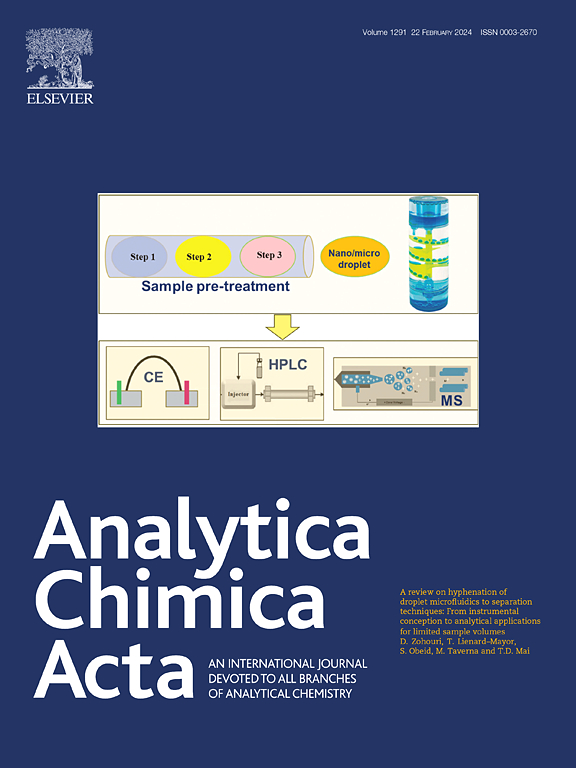Assessment of dried blood micro-sampling methods for oxylipin analysis in newborn blood using UPLC-MS/MS
IF 6
2区 化学
Q1 CHEMISTRY, ANALYTICAL
引用次数: 0
Abstract
Background
Conventional sampling methods for clinical analysis make use of plasma or serum and require large blood volumes, cold storage, and specialized handling. This renders them impractical and invasive, especially when dealing with vulnerable groups of patients and the analysis of low-abundant and unstable compounds such as oxylipins. Dried blood micro-sampling methods are designed for collecting minimally invasive small-volume blood samples (<100 μL), providing advantages in stability, handling, and storage. The aim of this study is to develop and compare micro-sampling approaches that can be readily implemented in clinical analysis circumventing the barriers of conventional sampling methods. (96)
Results
This study assessed the performance of Pre-Cut Dried Blood Spots (PCDBS) and Volumetric Absorptive Micro-Sampling (VAMS®) devices for determining oxylipins, using small-volume liquid whole blood sampling as reference. A Liquid Chromatography - tandem Mass Spectrometry method was successfully developed and validated. Both PCDBS and VAMS® were prepared using 30 μL of spiked blood and dried for 2 h before extraction and analysis. Optimal results were achieved by pre-treating devices with antioxidant before sample deposition and avoiding the internal standard to undergo evaporation steps during preparation of micro-sampling devices. Long-term storage effects were assessed over a three-month period, and the micro-sampling devices were tested on umbilical cord blood samples from 35 newborns. For PCDBS and VAMS®, eight and nine oxylipins, respectively, showed comparable results to those obtained from liquid whole blood samples with mean concentrations ranging between 0.7 and 6.3 nM (140)
Significance
This study is the first to analyse oxylipins in umbilical cord blood using VAMS® and PCDBS micro-sampling devices, demonstrating their effectiveness for quantification at nM concentrations. It highlights the impact of sample collection, storage, and internal standard handling on lipid profiles. Stability is critical and cold storage (−20 °C) is mandatory. Future research focusing on the standardization of protocols for comparability among laboratories and enhancing sensitivity with improved LC-MS/MS techniques to expand accessible oxylipins are needed. (75)


超高效液相色谱-质谱联用分析新生儿血液中氧磷脂的干血微采样方法的评价
传统的临床分析取样方法使用血浆或血清,需要大血容量、冷藏和专门处理。这使得它们不切实际且具有侵入性,特别是在处理弱势患者群体和分析低丰度和不稳定化合物(如氧化脂类)时。干血微采样方法用于采集微创小体积血液样本(100 μL),在稳定性、处理和储存方面具有优势。本研究的目的是开发和比较微采样方法,可以很容易地在临床分析中实施,绕过传统采样方法的障碍。(96)结果本研究评估了预切干燥血斑(PCDBS)和体积吸收微采样(VAMS®)装置测定氧化脂类的性能,以小体积液体全血取样为参考。建立了液相色谱-串联质谱联用方法并进行了验证。PCDBS和VAMS®用30 μL加标血制备,干燥2小时后提取分析。在样品沉积前用抗氧化剂对器件进行预处理,避免了内标在制备微进样器件过程中的蒸发步骤,获得了最佳结果。在三个月的时间内评估了长期储存效果,并对35名新生儿的脐带血样本进行了微采样装置测试。对于PCDBS和VAMS®,8和9个氧脂素分别显示出与平均浓度在0.7和6.3 nM之间的液体全血样品相似的结果。(140)意义本研究首次使用VAMS®和PCDBS微采样设备分析脐带血中的氧脂素,证明了它们在nM浓度下定量的有效性。它强调了样品收集,存储和内部标准处理对脂质剖面的影响。稳定性至关重要,必须冷藏(-20°C)。未来的研究重点是标准化实验室间的可比性方案,并通过改进的LC-MS/MS技术提高灵敏度,以扩大可获取的氧化脂类。(75)
本文章由计算机程序翻译,如有差异,请以英文原文为准。
求助全文
约1分钟内获得全文
求助全文
来源期刊

Analytica Chimica Acta
化学-分析化学
CiteScore
10.40
自引率
6.50%
发文量
1081
审稿时长
38 days
期刊介绍:
Analytica Chimica Acta has an open access mirror journal Analytica Chimica Acta: X, sharing the same aims and scope, editorial team, submission system and rigorous peer review.
Analytica Chimica Acta provides a forum for the rapid publication of original research, and critical, comprehensive reviews dealing with all aspects of fundamental and applied modern analytical chemistry. The journal welcomes the submission of research papers which report studies concerning the development of new and significant analytical methodologies. In determining the suitability of submitted articles for publication, particular scrutiny will be placed on the degree of novelty and impact of the research and the extent to which it adds to the existing body of knowledge in analytical chemistry.
 求助内容:
求助内容: 应助结果提醒方式:
应助结果提醒方式:


